Related Research Articles

Bristol Zoo was a zoo in the city of Bristol in South West England. The zoo's stated mission was to "maintain and defend" biodiversity through breeding endangered species, conserving threatened species and habitats and promoting a wider understanding of the natural world".

The Madagascar day gecko is a diurnal species of gecko. It lives on the eastern coast of Madagascar and typically inhabits rainforests and dwells on trees. The Madagascar day gecko feeds on insects, fruit and nectar.
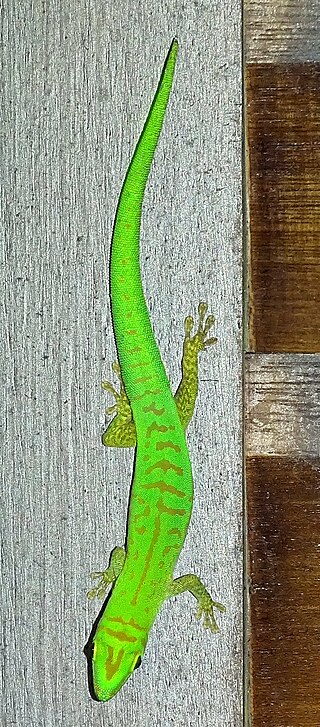
Phelsuma astriata astriata is a subspecies of Seychelles small day gecko. It is a small, slender lizard with bright green colour that feeds primarily on insects. It is found on several islands of the Seychelles.

Barbour's day gecko is a species of lizard in the family Gekkonidae. The species is endemic to central Madagascar. It is diurnal and typically dwells on rocks. Barbour's day gecko feeds on insects and nectar.

The Round Island day gecko, also known as Günther's gecko, is an endangered species of gecko. It lives on the islet Round Island (Mauritius), and typically dwells on different palm trees. The Round Island day gecko feeds on insects and nectar.
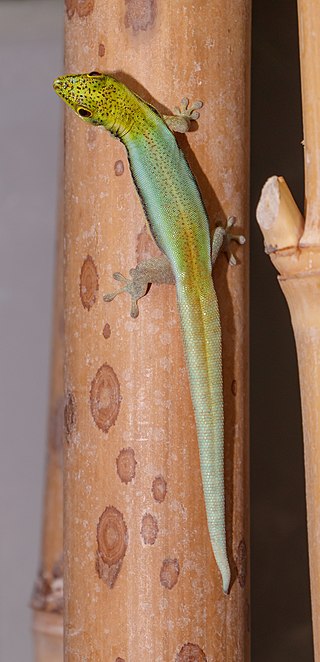
The yellow-headed day gecko, also commonly called Klemmer's day gecko, the neon day gecko, or the cheerful day gecko, is a small diurnal species of gecko, a lizard in the family Gekkonidae. This endangered species is endemic to northwestern Madagascar and inhabits coastal forests, dwelling on bamboo. The yellow-headed day gecko feeds on insects and nectar.

The gold dust day gecko is a diurnal species of gecko. It lives in northern Madagascar, Tanzania and on the island of Comoros; it has also been introduced to Hawaii and other Pacific islands. It's typically seen in houses and various trees. The gold dust day gecko feeds on insects and nectar.
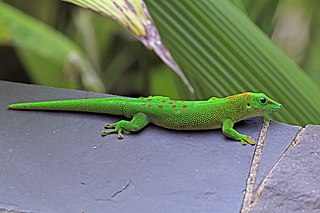
Phelsuma grandis is a diurnal arboreal species of day gecko. These geckos are part of the Phelsuma group, which consists of in excess of 70 species and subspecies. They are commonly referred to as the Madagascar giant day gecko, due to their large size. They are native to areas of tropical and subtropical forest in northern Madagascar, but have been introduced to several other subtropical locations outside their range. P. grandis feeds on various invertebrates, very small vertebrates, and nectars. It is bred and sold as an exotic pet.

Koch's giant day gecko is a diurnal subspecies of gecko, a lizard in the family Gekkonidae. The subspecies is native to northwestern and western Madagascar and typically inhabits trees. It feeds on insects and nectar.
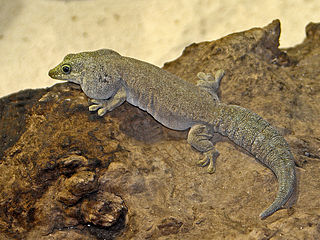
Standing's day gecko is an arboreal and diurnal species of lizard in the family Gekkonidae. The species is endemic to southwest Madagascar; it is threatened by illegal collection for the international pet trade and habitat loss. It is among the largest living species of day geckos. Standing's day gecko feeds on insects and nectar.

The Oakland Zoo is a zoo located in the Grass Valley neighborhood of Oakland, California, United States. Established on June 6, 1922, it is managed by the Conservation Society of California, a 501(c)(3) non-profit organization dedicated to the conservation of wildlife both locally and globally. The zoo is home to more than 850 native and exotic animals. It is recognized for its outstanding leadership in animal welfare, animal care, particularly its elephant care program, its rescue, rehabilitation and conservation programs and for its Leed-certified, 17,000-square-foot, state-of-the-art veterinary hospital—the largest wild animal veterinary facility in Northern California. Oakland Zoo is the recipient of numerous "Best of" awards, including 30 Best U.S. Zoos by U.S. News & World Report and "10 Best" by USA Today Reader’s Choice Awards.

Zoo Atlanta is an Association of Zoos and Aquariums (AZA) accredited zoological park in Atlanta, Georgia. The current president and CEO of Zoo Atlanta is Raymond B. King.

The Los Angeles Zoo and Botanical Gardens is a 133-acre (54 ha) zoo founded in 1966 and located in Los Angeles, California, United States. The city of Los Angeles owns the zoo, its land and facilities, and the animals.

The radiated tortoise is a tortoise species in the family Testudinidae. Although this species is native to and most abundant in southern Madagascar, it can also be found in the rest of this island, and has been introduced to the islands of Réunion and Mauritius. It is a very long-lived species, with recorded lifespans of up to 188 years. These tortoises are classified as critically endangered by the IUCN, mainly because of the destruction of their habitat and because of poaching.
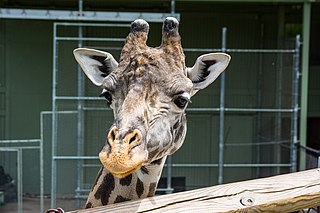
The American Species Survival Plan or SSP program was developed in 1981 by the (American) Association of Zoos and Aquariums to help ensure the survival of selected species in zoos and aquariums, most of which are threatened or endangered in the wild.
Peter Brazaitis is an American herpetologist and forensic specialist in herpetology and worked for the Wildlife Conservation Society from 1954 to 1998. He began as a reptile keeper at the Bronx Zoo, became Senior Keeper in 1967, Assistant Animal Manager in 1970, and Superintendent of Reptiles in 1972. In 1988, he transferred to the Central Park Wildlife Center as Assistant Curator of Animals and became Curator of Animals in 1990, a position he held until his retirement in 1998.
John L. Behler was an American naturalist, herpetologist, author, and activist known for his work in conserving endangered species of turtles, snakes, and other reptiles. He served as curator of herpetology at the Bronx Zoo, part of the Wildlife Conservation Society from 1976 to 2006. He co-chaired the IUCN Tortoise and Freshwater Turtle Specialist Group, and was a founding member of the Turtle Survival Alliance, which co-present the Behler Turtle Conservation Award with the Turtle Conservancy and Turtle Conservation Fund. The Behler Turtle Conservation Award is a major annual award to honor leadership in the field of freshwater turtle and tortoise conservation. The Turtle Conservancy named its captive breeding center, the Behler Chelonian Center, in his honor.

Mario Giacinto Peracca was an Italian herpetologist.
James Arthur Oliver was an American zoologist, herpetologist and educator who served as the Director of the American Museum of Natural History, the New York Zoological Park and the New York Aquarium.